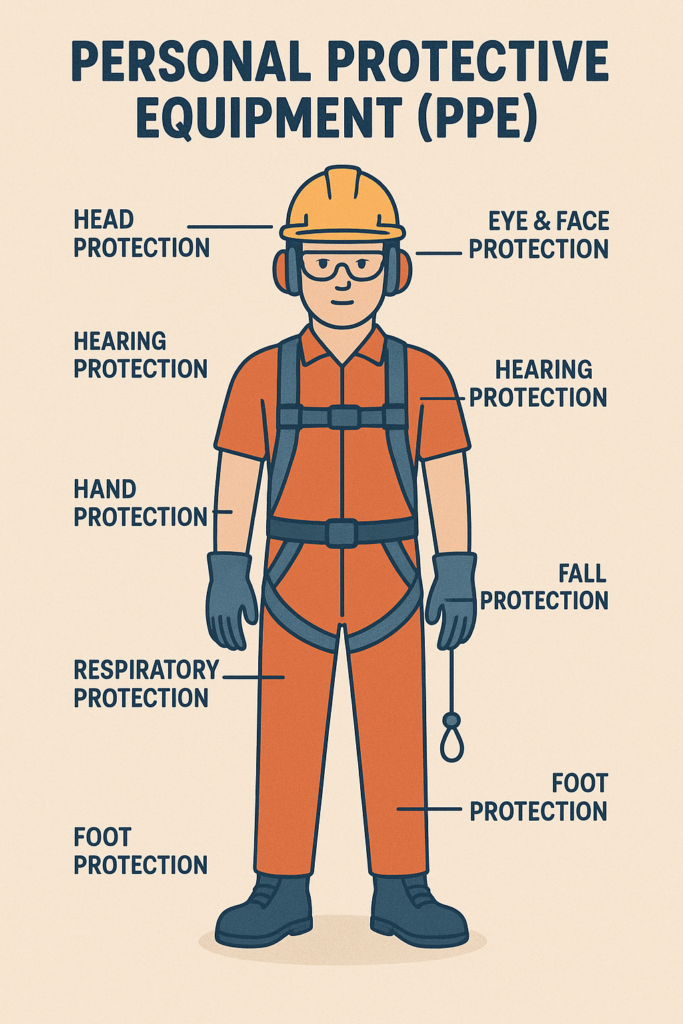
Importance of Personal Protective Equipment (PPE) Toolbox Talk (TBT)
1. Introduction
Good morning, team!
Today, we are going to discuss Personal Protective Equipment (PPE)—one of the most essential safety measures on the worksite. PPE acts as a barrier between workers and workplace hazards, helping to reduce the risk of injuries and health issues.
Failure to wear PPE properly can result in serious injuries or even fatalities. That’s why it’s crucial to understand what PPE is, why we need it, and how to use it correctly.
2. What is PPE?
PPE stands for Personal Protective Equipment—the gear workers wear to protect themselves from hazards. It includes items like helmets, gloves, safety glasses, and more.
3. Why is PPE Important?
PPE protects workers from various workplace hazards, such as:
✅ Falling objects
✅ Flying debris
✅ Chemical exposure
✅ Electrical hazards
✅ Sharp tools and surfaces
✅ Loud noise levels
4. Types of PPE and Their Uses
🔹 Head Protection (Helmets/Hard Hats) – Protects against falling objects and head injuries.
🔹 Eye and Face Protection (Safety Glasses/Goggles/Face Shields) – Shields eyes from dust, chemicals, and flying debris.
🔹 Hearing Protection (Earplugs/Earmuffs) – Protects against excessive noise that can cause hearing loss.
🔹 Respiratory Protection (Masks/Respirators) – Prevents inhalation of dust, fumes, and hazardous chemicals.
🔹 Hand Protection (Gloves) – Protects hands from cuts, burns, and harmful substances.
🔹 Foot Protection (Safety Boots) – Prevents injuries from falling objects, punctures, and electrical hazards.
🔹 Body Protection (Coveralls/Vests/Aprons) – Shields the body from heat, chemicals, and impact.
🔹 Fall Protection (Harnesses/Lanyards) – Prevents falls from heights.
5. Proper Use and Maintenance of PPE
🔹 Always wear the right PPE for the task.
🔹 Inspect PPE before use—check for damage, cracks, or defects.
🔹 Keep PPE clean and store it properly.
🔹 Do not modify or misuse PPE.
🔹 Replace damaged or worn-out PPE immediately.
🔹 Follow company policies and safety regulations regarding PPE.
6. Common Mistakes Workers Make with PPE
🚫 Not wearing PPE at all
🚫 Wearing damaged or improper PPE
🚫 Removing PPE while still in hazardous areas
🚫 Using PPE incorrectly (e.g., wearing a loose hard hat)
🚫 Failing to maintain or store PPE properly
7. Real-Life Example
Let’s consider an example:
A worker was cutting metal without wearing safety glasses. A small piece of metal debris flew into his eye, causing severe injury. This accident could have been prevented if the worker had worn safety glasses.
This example highlights why PPE is not optional—it is a life-saving necessity.
8. Closing & Worker Engagement
PPE is provided for your protection—make sure to wear it at all times and use it correctly. If you have any concerns about your PPE, report it immediately.
🔹 Does anyone have questions about PPE?
🔹 Can someone share an example of when PPE helped them avoid injury?
Remember: “Your safety is in your hands. Wear PPE and stay protected!”
Electrical Safety Toolbox Talk (TBT)
Excavation Safety Toolbox Talk (TBT)
Work at Height Safety Toolbox Talk (TBT)